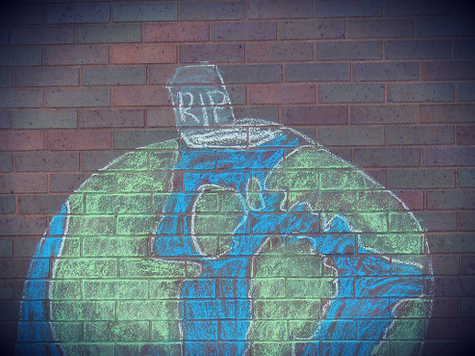The emperor was proudly parading his clothes this weekend, as the Intergovernmental Panel on Climate Change (IPCC) met in Copenhagen to release its new report into climate catastrophe. In line with previous reports, the latest offering has again gone one step further, predicting “severe, pervasive and irreversible” damage unless emissions fall below zero within this century.
The recommended method for achieving emissions reversal is simple: burn more trees.
IPCC Chairman Rajendra Pachauri warned “we have little time before the window of opportunity to stay within 2˚C of warming closes. The cost of inaction will be horrendously higher than the cost of action,” the Times has reported.
His panel’s synthesis report, a summing up of the 5,000 pages by 800 scientists published in the previous three reports, is designed to persuade governments to come to an agreement on reducing emissions. The report warns that emissions need to fall by between 40 and 70 percent by 2050 from a 2010 base level, and be “near zero or below in 2100” if disaster is to be averted.
Computer models used by the IPCC to predict warming have shown that the best way to achieve negative emissions is through planting billions of trees to soak up CO2, then burning them in plants fitted with carbon capture and storage systems. According to the models, this method would ensure that global average temperatures would not rise beyond the crucial 2˚C above preindustrial levels threshold, thought to be the tipping point at which irreversible damage would occur.
Currently, only one commercial-scale CCS plant has been built: the Boundary Dam project in Canada, at a cost of £750million.
Sir Mark Walport, the government’s chief scientific adviser, said: “We can still avoid the most serious impacts. We need to transform the way we power our lives. This will be very challenging, but the challenges for humanity if we do not are likely to be far greater.”
The report also suggests adopting targets to produce 80 percent of electricity from low-carbon sources by 2050, and to phase out fossil fuels entirely by 2100.
Myles Allen, a University of Oxford climate scientist and one of the lead authors on the report has said that the writing team had sidestepped making “alarmist” claims, unlike Greenpeace and others.
However, the suggestion that burning more trees may stave off climate disaster may be seen as in extraordinarily bad taste to many in the developing world. According to the World Health Organisation, 4.3 million people die each year from indoor air pollution, caused by having to burn wood fires indoors for heat and to cook rather than have access to electricity.
Yet the environmental movement continues to pressure governments into refusing funding for coal-fired power stations in Africa and Asia, stations which would supply the electricity these people need to access energy in their homes safely.
Delivering the annual lecture to the Global Warming Policy Foundation, Europe’s only climate realist think tank, former environment secretary Owen Patterson said: “The sight of rich film stars effectively telling Africa’s poor that they should not have fossil fuels, but should continue to die at the rate of millions each year from the smoke of wood fires in their homes frankly disgusts me.
“The lack of affordable and reliable electricity, transport and shelter to help protect the poor from cyclones, droughts and diseases, is a far greater threat to them than the small risk that those weather systems might one day turn a bit more dangerous.”

COMMENTS
Please let us know if you're having issues with commenting.